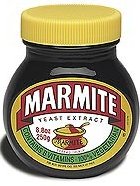Marmite
“Thrush in a pot.”
– Oscar Wilde on Marmite
Marmite is a British brand of sump oil, more suitable for colder weather conditions than the Australian equivalent, Vegemite. Its flavour is an intriguing cross between soy sauce, beef, and burnt matches. Even so, it is admittedly an acquired taste. Marmite has become sought after by tourists the world over, traveling many miles to sample its delights.
Marmite is known for its notable advertising slogan, "I hate Marmite". This was intended to increase sales in the BDSM community. Unfortunately several prominent masochists found themselves not enjoying not enjoying the product, and successfully sued Marmite's manufacturers for misleading advertising.
It should not be confused with the similar products Natex (made from refined rubber) or Vecon (famous in the 1950s after appearing in an episode of the soap opera Dan Dare). It should also not be confused with refined tar, although refined tar has a sweeter taste and less pungent aroma.
Few people know that Marmite is mined from underground wells and these are currently in operation in Harrogate in England (see below), northern Uzbekistan, Nigeria, Tanzania, Tennessee and Ecuador.
History[edit | edit source]
Marmite was first mined by the ancient Egyptians on around April 16 872 BC. However, it was soon forgotten about and then discovered by the Romans in 14 AD. However, the Romans chose to use it as a lubricating oil, rather than a foodstuff. By the fall of the Holy Roman Empire, Marmite resources had been exhausted and they had been forced into using hot chilli oil as lubrication. In 1782, Lord William Pembleton-Fotheringham-Smythe of Harrogate found an underground source of Marmite, which he used feed his slaves.[1]
Marmite, a thick semi-liquid hydrocarbon resulting from the fractional distillation of crude oil, was utilized at the start of the Industrial Revolution. In terms of thickness, Marmite comes after asphalt and before diesel fuel. In 1960, oil drillers found a large well of Marmite a few miles out from Australia's Gold Coast. This baffled most scientific minds because, until then, the Southern Hemisphere had only yielded Vegemite.
Pot[edit | edit source]
Yep, Pot. It's a type of Pot (for cooking). A marmite pot.
Fauna[edit | edit source]
Small furry brown creatures similar to beavers typically found in Alpine meadows well above the tree line. Noted for their distinctive squeak and appetite for human flesh. Along with pikas, it is considered the food of last resort among high-altitude carnivores and other marmites.
Marmite in science[edit | edit source]
Marmite is the only known substance in the universe which actually absorbs energy. It even absorbs light, explaining why it has an unusual black surface. Scientists have a theory that if a Marmite atom were ever split (impossible because of its metamorphic shape) the energy released would destroy the entire universe seven times over.
Marmite and warfare[edit | edit source]
Marmite has been used in multiple wars, partly because of the distracting properties of it, but mainly because it is effective as a trap, shield, projectile and, in extreme cases, a snare for wildlife. Truly amazing.
It should be noted that the alleged poisoning of Walter Litvinenko, an ex Russian spy, was not carried out with polonium-210. Really, a shady enemy secretly waited until Litvinenko glanced away from his sushi dinner, and while he was distracted spooned Marmite over the fish. Marmite is a radioactive element that is not found naturally, and so must be manufactured for use in war.
Marmite and music[edit | edit source]
Marmite can be played as an instrument by stirring it with a spoon. A (possibly apocryphal) story in Jane's Defence Weekly in June 1850 suggested that experimental composer Mozart von Bach had written a fugue solely for a 'Marmitophone'. This instrument has never been recovered.
"Marmite" was the name of a 1980s new-wave band that experienced mild popularity, but broke up after the death of its lead singer Oscar Wilde due to a barbiturate overdose. I'm sure if you ask that asshole music-snob that rooms with you, you'll find out a lot more. Including that they totally sold out after their first, self-titled album.
Facts[edit | edit source]
In 2007 Apple released a version of the iPod touch which tasted like marmite. Whether this was part of Apple's plan, we are not sure. All we do know is that when it was left out in the sun, it melted, got sticky and tasted funny.
Marmite was originally named Vegemargarmititixiticus, but was renamed Marmite in 1847 to avoid people disliking the brown substance.
In 2002, a factory in New Zealand producing 30,000 tonnes of Marmite per second, went up in flames after a jar of Marmite ignited and started a blaze. Firefighters worked 92 consecutive days fighting the fire, and it was then that the creators of Marmite realised Marmite was flammable.
Notes[edit | edit source]
- ↑ For much of the 18th and 19th centuries, it was widely believed by the public that the active agent in Marmite were real Africans, hence its blackness and poor taste. This does, however, contribute to the low, low cost of Marmite as African people can be bought very cheaply, especially Ethiopians.






